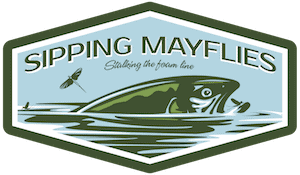Dragonfly pattern fly fishing – Flies and Tactics
June 3rd, 2022
Dragonfly patterns are vastly overlooked within the fly fishing community, and I’m not quite sure why. Everyone parrots the tenet of “match the hatch,” so when dragonflies are flying all around, why not tie one on your line?
Perhaps not as elegant as a mayfly, dragonflies are fierce predators much like the fish that hunt them. While these insects are expert aviators, they do end up in the water occasionally and fish eat them ravenously.
Even the dragonfly nymphs are relished by gamefish as a large protein bonus.
In the below article, I’ll explain to you the difference between dragonflies and damselflies, their life cycles, fly fishing techniques, and the best dragonfly patterns I’ve used.
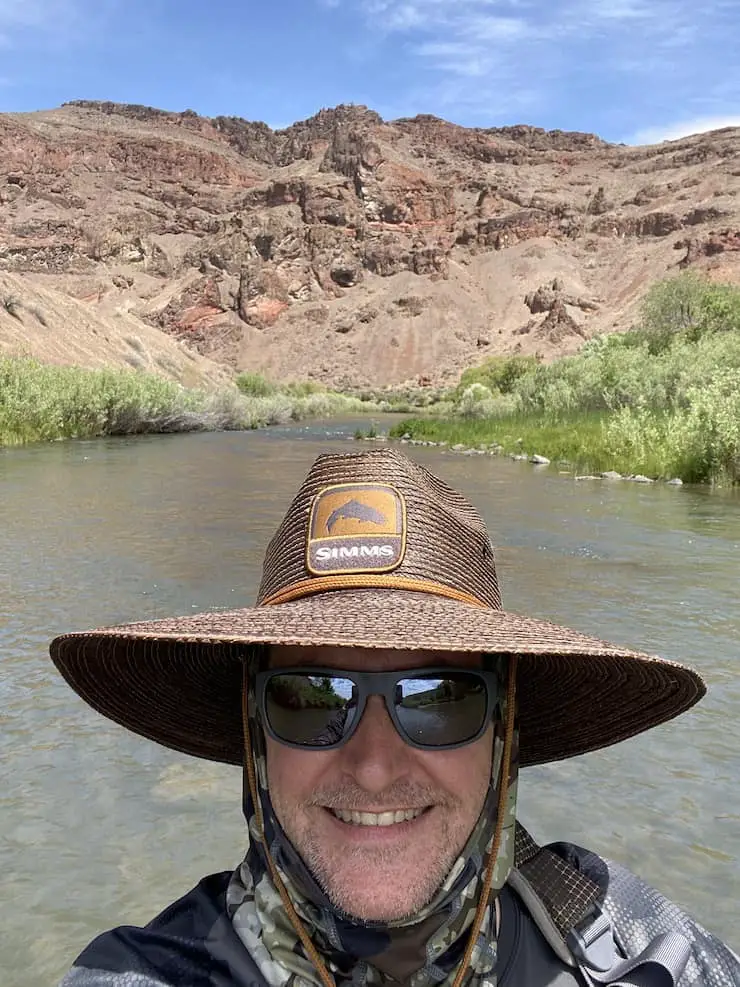
In the above picture taken in very early June, dragonflies and damselfies were out in full force on the river.
What Fish Eat Dragonflies?
Dragonflies are a favorite prey item of several gamefish species, including rainbow trout, brown trout, largemouth bass, and especially smallmouth bass. Dragonflies are a prized food because they provide a calorie-packed protein meal for these fish.
Panfish such as sunfish and crappies are too small to eat an adult dragonfly, but they can overpower and eat damselflies, which are considerably smaller.
I’ve seen trout jump out of the water trying to catch a dragonfly in mid-flight.
In fact, in my article on Fly Fishing the Middle Fork of the American River, I told the story of a fly fishing guide who I met on that river. He had seen so many brown trout leap out of the water at dragonflies that he concocted a novel device.
It looked like a 3-foot long fishing pole, with a couple feet of fishing line attached to the tip. On the other end of the fishing line he had tied-on a dragonfly pattern. He said his goal was to catch a brown trout above the water’s surface. What a cool idea.
The green darner (Libellulidae) is the dragonfly species you’ll see most often in North America, and so you should focus your efforts on imitating it while fly fishing and tying.
Here’s a video I took of a dragonfly I saw on a branch while I was fly fishing in a river in June.
Dragonfly Life Cycle
Dragonflies are members of the Odonata order of insects. The Odonata order is comprised of three distinct groups: Anisoptera (dragonflies), Zygoptera (damselflies), and Anisozygoptera (lives only in Japan and in the Himilayas).
You’ll find dragonflies buzzing around ponds, streams, lakes, and rivers. They’re strong insects that can tolerate a wide range of temperatures. Adults can fly up to 60mph, which is insane, and they’re extraordinarily effective hunters.
Let’s learn how they become such formiddable predators.
Dragonflies hatch underwater from relatively tiny eggs (around .5mm in diameter). Once they emerge from the egg, they’re considered nymphs and they begin hunting almost immediately after their first molt.
The aquatic nymphs viciously hunt other nymphs, tadpoles, minnows, and scuds (crustaceans similar to shrimp).
The nymph stage generally lasts a year, but it can take up to six years. During this year of underwater existence, they’ll molt quite a few times, up to 15, as they mature.
Once mature, the nymphs crawl along the river or lake bottom and maneuver their way up onto shoreline plants and brush where they’ll emerge from their nymphal exoskeleton (casing), and become adults. This process usually takes place at night to avoid predators.
The next several hours are spent allowing their large wings to dry completely.
The adult dragonfly’s main mission is now to mate and reproduce. You’ve probably seen mating pairs flying around attached to each other. Reproduction generally takes place in late spring and early summer.
Their eggs are laid on waterside vegetation, muddy puddles, or directly into the water.
Here’s a picture of the same dragonfly that was in the above video.
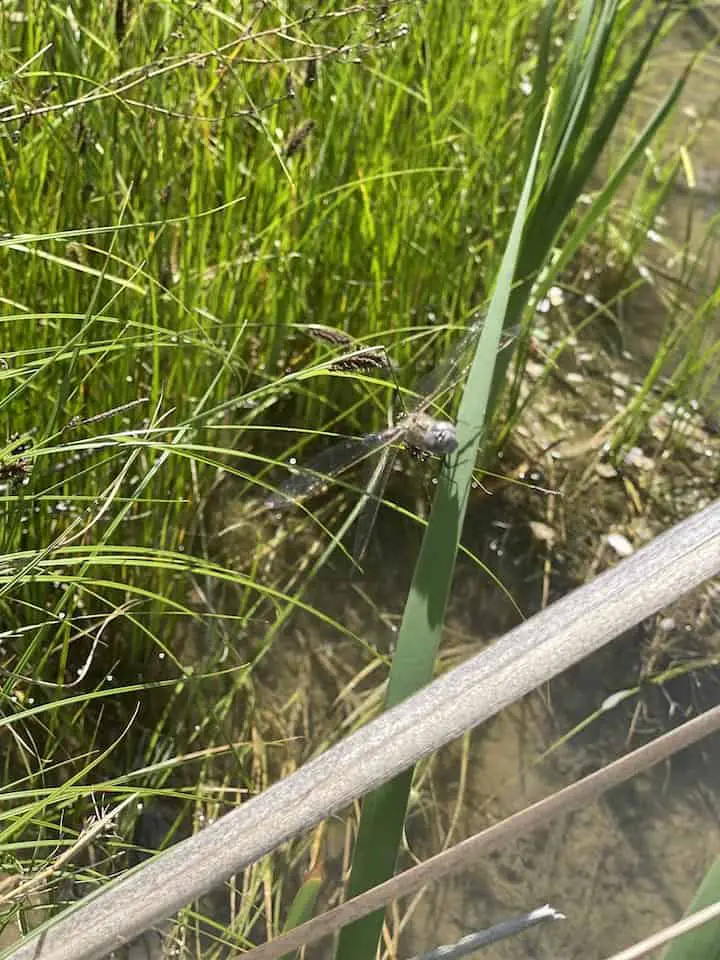
Dragonfly vs Damselfly
The simplest on-the-water description is this: dragonflies are huge, damselflies are small.
Dragonflies can attain a length of up to 4-inches long, while damselflies reach just a couple inches in length. Supposedly, in prehistoric times, dragonflies had wingspans of up to 30-inches.
Another telltale sign is that dragonfly wings are extended while they are at rest (perpendicular to the body), while damselfly wings are pulled in so they are parallel with the body.
Finally, in North America, damselflies are almost always light blue in coloration.
Ironically, damselfly eggs are about twice the size of dragonfly eggs.
I was casting my fly on a remote river one summer a couple years ago, and on my forward cast it felt like I hit a small rock in mid-air. Yes, I know rocks don’t fly, but in that millisecond that’s what it felt like.
Of course, it wasn’t a rock, you’re way ahead of me. It was a large dragonfly, and despite the walloping, it kept flying.
Fly Fishing Dragonfly Patterns
There are two ways to fly fish with dragonflies. The first is with nymph imitations, and the second is with adult imitations. Both can be very effective, but my personal favorite is casting the adult dry flies.
Dragonfly Nymphs
Dragonfly nymphs (larvae) are ever-present in most rivers and lakes in North America. They’re bigger than the nymphs you usually use, usually in fly sizes 8-12. They avoid fast water, so if you’re fishing a river, focus on the pool sections.
Like most nymph fishing, you want to get your flies near the bottom, where the actual nymphs live. You can do this by using a weighted (beadhead) nymph pattern, or by using sinking line, or both.
Fluorocarbon line will be advantageous since it’s not only stronger and less visible, but it’ll also sink easier than monofilament line.
When nymphing, use short 3-6 inch jerks. This is how the dragonfly nymphs move through the water, in short bursts.
Dragonfly Dry Flies (including Damselflies)
These are the adult-imitation fly patterns. In other words, they look like a mature dragonfly. They’re very effective for trout (rainbow and brown), largemouth bass, and smallmouth bass.
You’ll want to use these flies in sizes 4-10. They’re big.
The size and shape of the fly is much more important than the exact coloration, in my experience. When the fish is looking up at the fly from underwater, the silhouette needs to look accurate.
You want the dragonfly pattern to hit the water hard–a loud, splashy landing is your goal. This attracts the fish’s attention.
Then, give the fly some short, quick jerks and twitches. Just a few inches at a time, and don’t overdo it.
When you’re casting, avoid false casts since the wings on the dragonfly pattern will act like propellers and will badly twist your leader and tippet.
Damselfly patterns can be really effective for panfish such as sunfish and crappie since they can’t subdue and eat a fully grown dragonfly.
Best Dragonfly Fly Patterns
There aren’t any “best seller’ dragonfly fly patterns, nothing that’s mainstream, due mainly to the notion that most fly anglers ignore them. In fact, they’re not even listed on some of the biggest online fly shop websites.
Think of them as a specialty fly pattern.
So, I’ll just show you the dragonfly imitation that’s lured the most fish for me, and you can do an online search for it or something similar. Again, it’s mostly about matching the outline or silhouette, not specific colors or details (such as the number of legs).
If you’re looking to try out some damselfly fly patterns, you can get a nice assortment of them on this page at Amazon.
Alternatively, if you’re into fly tying, these aren’t complicated patterns for your vise. They’re generally made out of foam, deer hair, and other very buoyant materials.
Here’s a picture of my favorite dragonfly patterns from my fly box. I’ve added descriptions in the image.
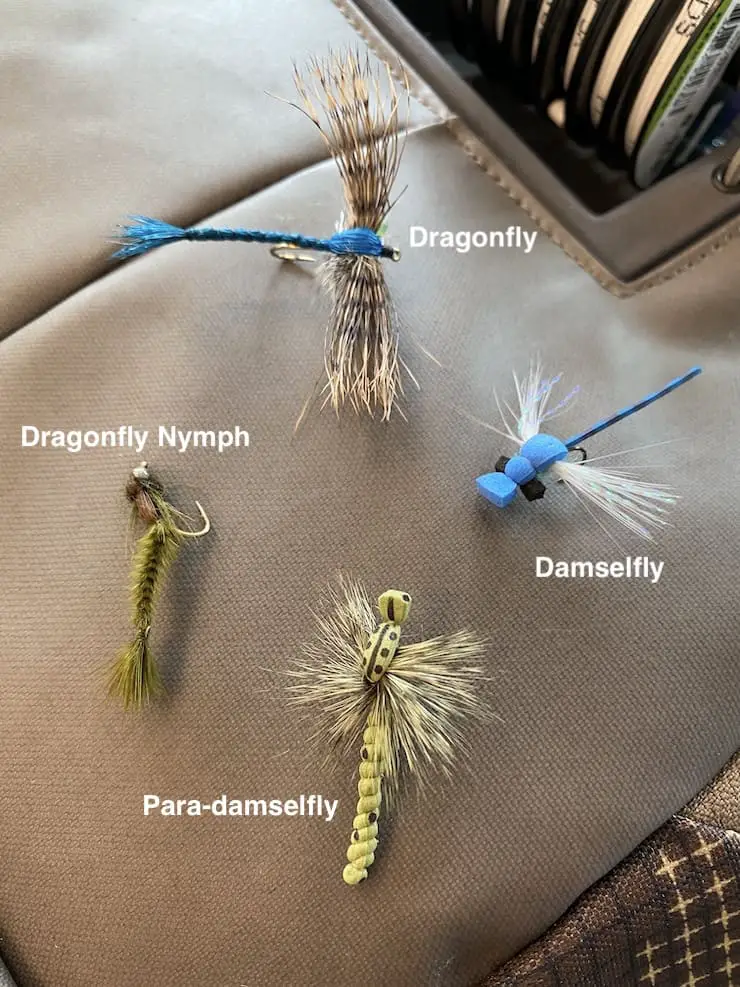
Summary
Fly fishing with dragonfly (and damselfly) patterns can be super productive during certain times of the year, most notably late spring and through the summer. Avoid these flies entirely during the last half of fall and all of winter.
If you’re into spinfishing, there are dragonfly lures available in that market as well. Regardless of your presentation preferences, fish avidly eat these prehistoric insects.
The next time you’re on the water and you see a dragonfly buzz by you, consider tying on an imitation. It doesn’t take long to test the fish (usually rainbow trout, brown trout, largemouth bass, and smallmouth bass) and find out if they’re keying-in on these bugs.
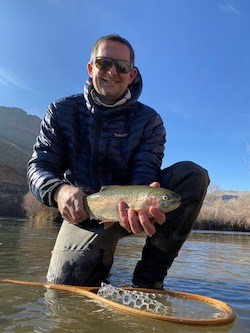
About the Author
My name's Sam and I'm a fly fishing enthusiast just like you. I get out onto the water 80+ times each year, whether it's blazing hot or snow is falling. I enjoy chasing everything from brown trout to snook, and exploring new waters is something I savor. My goal is to discover something new each time I hit the water. Along those lines, I record everything I learn in my fly fishing journal so I can share it with you.
Follow me on Instagram , YouTube, and Facebook to see pictures and videos of my catches and other fishing adventures!
